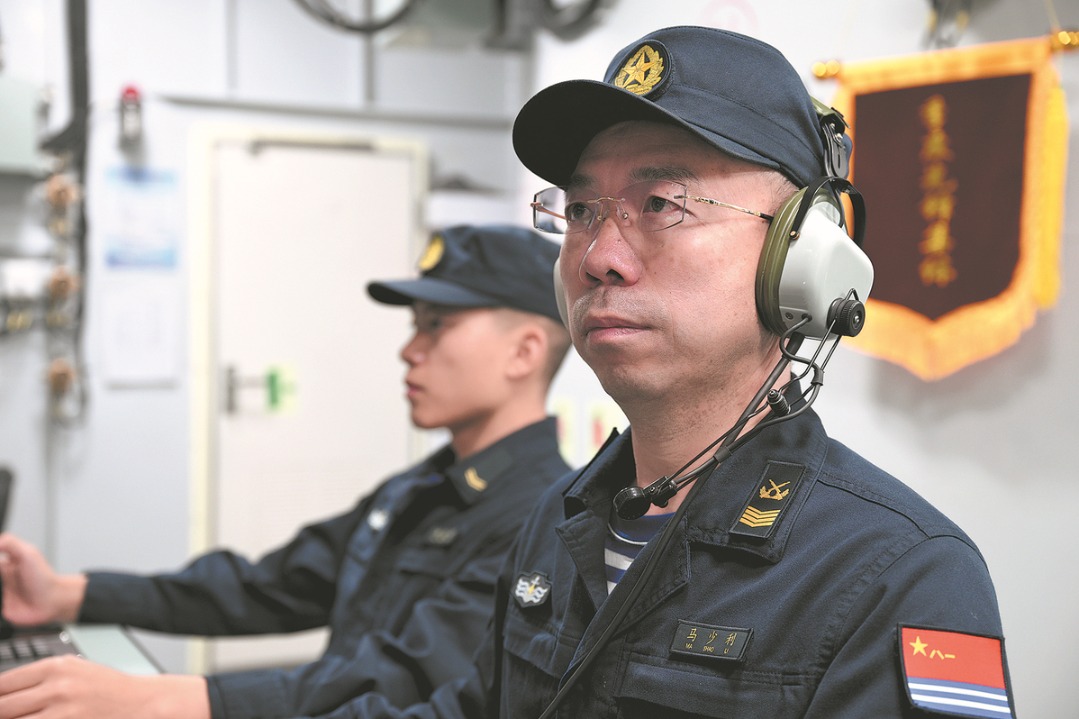Integrated tertiary studies to expand job options

Hong Kong graduates have limited scope in a narrow services economy. Integrated universities on the Chinese mainland give students insights into society, economy and peer networking. Cross-border policy alignment is vital to fully energize the Greater Bay Area. Zhou Mo reports from Hong Kong.

Hong Kong's economy receives over 90 percent of its GDP from services sectors. The city's narrow economic structure severely restricts career choices for local university graduates.
Speaking to students at the United International College, a pioneering collaboration in Zhuhai, Guangdong province between Beijing Normal University and Hong Kong Baptist University, Leung Chun-ying, vice-chairman of the National Committee of the Chinese People's Political Consultative Conference, pointed to the more diverse economic structure of the Chinese mainland, for greater job opportunities.
Leung said that tertiary studies with mainland students will give Hong Kong undergraduates a deeper understanding of the national economy, mindset, and society, while nurturing peer group networking for jobs.

The 14th Five-Year Plan for Education Development in Guangdong Province anticipates three to five new cooperative educational institutions between Guangdong, Hong Kong and Macao by 2025. Additionally, three to five unincorporated cooperative institutions and joint research institutions will also be set up within that time.
"Integration of higher education in the (Guangdong-Hong Kong-Macao) Greater Bay Area has been vigorous in the past few years and it is necessary to push forward," said Ronald Chan, founding president of The Greater Bay Area Education Integration and Development Think Tank.

Mutual benefits
Hong Kong universities are highly internationalized, with management systems and curricula benchmarked to global standards with global recognition, said Chan.
"Collaboration with the mainland will help drive high-quality development and breakthroughs for mainland universities mirroring Hong Kong's flexible and forward-looking education system," he added.
The Hong Kong University of Science and Technology (Guangzhou) is the third cooperative university between the mainland and Hong Kong approved by the Ministry of Education. That follows UIC in 2005, and the Chinese University of Hong Kong (Shenzhen) in 2014.
The mix of the first group of undergraduate students at HKUST (GZ) is 125 from the mainland, 12 from Hong Kong, Macao and Taiwan, and three from abroad. They will commence at the Guangzhou campus in Nansha district of the Guangdong provincial capital next month.
Such cooperation is accelerating with the City University of Hong Kong (Dongguan), the University of Hong Kong (Shenzhen), Hong Kong Polytechnic University (Foshan) and Hong Kong Metropolitan University (Zhaoqing) in the pipeline.

Policy alignment, talent mobility
Higher education in the GBA requires guarantees in stable policy and talent mobility, noted Chow Man-kong, associate vice-president(institutional advancement) of the Education University of Hong Kong. "Policy stability is essential to let people know that educational cooperation in the GBA is long term and in-depth," said Chow.
Funding is the "biggest limitation" for Hong Kong universities to operate across the border, said Chow, who is also a member of Hong Kong's Legislative Council. "If Hong Kong's subsidized institutions want to operate on the mainland, they cannot use funding from the Hong Kong Special Administrative Region government. They must find other funding sources, such as donations or bank loans." Chow said the government should provide financial support to those universities, instead of expecting them to raise funds.
"Policy coordination is the most serious challenge facing mainland and Hong Kong universities in the process of collaboration," said Victor Kwok, education and youth researcher at Our Hong Kong Foundation.

"It is necessary to create a win-win situation by addressing policy issues that need to be better aligned," said Kwok. The issues range from courses offered, personnel placement, mutual recognition of degrees, taxation and visas.
The positioning and development goals of universities affect cross-border cooperation. "Some universities have a clear development blueprint and complement partner strengths, but overlapping courses should be streamlined," noted Kwok.
"Talent mobility is also very important. We need to strengthen communication on population and talent policies, encourage talent from Hong Kong and the mainland to study, work, and set up enterprises across the border. Meanwhile, we need to increase internship opportunities for students, and introduce better human resources policies to build youth confidence in the value of higher education in the GBA," added Chow.

Quota restrictions
Hong Kong's publicly funded universities set a 20 percent quota on the admission of first-year-first-degree nonlocal students, or 3,000 places, a policy Chow believes should be reformed.
"This policy itself is unreasonable. Other major study-abroad countries such as the United Kingdom and New Zealand do not have such protectionist measures. It is not appropriate for Hong Kong to implement such protectionism, and it must be dismantled," stressed Chow.
He suggested increasing the proportion of nonlocal students, as demographics show a decline in the young population. There are reports that the University Grants Committee in Hong Kong plans to raise the nonlocal student quota to 40 percent in the 2024-25 academic year.
Kwok urged the cooperating universities to consider double degree programs, for students to earn mutual recognition of credits. "Through double-degree programs, universities from Hong Kong and the mainland can provide complementary resources, promoting talent flow in the GBA. The ultimate goal is to foster a university ecosystem in the region, and attract global young talent," he said.

Global ranking
In the 2022 Third-party University Ranking Indices, of the 1,905 universities covered, 157 are in the world's four bay areas - New York Bay Area, San Francisco Bay Area, Tokyo Bay Area and Guangdong-Hong Kong-Macao GBA, accounting for 8.24 percent of the total.
The GBA ranked second in the index with 49.66 points, behind the New York Bay Area, which scored 100 points. Tokyo and San Francisco bay areas ranked third and fourth, at 44.44 points and 41.64 points, respectively.
Twenty-four universities in the GBA made it onto the list, with two ranking among the Top 100 worldwide - the University of Hong Kong at 67th place and the Chinese University of Hong Kong at 83rd.

Inno-tech ecosystem
With outstanding academic strengths, the GBA can develop global leadership in innovation and technology. Much effort is needed for Hong Kong and other cities in the region to fully exploit their strengths, observed Chan.
"Hong Kong's universities are not short of research achievements, but they are often confined to the academic stage. After the publication of papers in world-class journals, the process seems to halt, with no effective commercialization." Chan highlighted the need to ally with mainland cities in the GBA, to leverage their industrial chains to turn ideas into real products.
The scholar called for a review of the university appraisal system to encourage staff to move beyond research. "Instead of focusing on how many papers they have published, more attention should be paid to contribution to social progress, and the improvement of people's livelihoods," asserted Chan.

Gap persists
The Higher Education and Economic Development Report of Guangdong-Hong Kong-Macao, Beijing-Tianjin-Hebei, and Yangtze River Delta Region - published last year by the Greater Bay Area Data Center of Higher Education at Southern University of Science and Technology in Shenzhen, recorded 18 percent growth from 2010 to 2020 of higher education institutions in the GBA.
The 11-city cluster GBA had 183 in 2020, an increase of 11 from 2015. The San Francisco Bay Area, meanwhile, registered 81 in 2020, dropping by 13 from 2015. According to the report, the GBA had 1,776 people studying in higher education institutions for every 100,000 people. That is 20 percent of the San Francisco Bay ratio of 8,913 per 100,000.
The GBA committed 32 billion yuan ($4.39 billion) to research and development in 2019, higher than San Francisco Bay Area's 26 billion yuan. But the per capita average R&D spending was 560,000 yuan, compared with 800,000 yuan for the San Francisco Bay Area.
Government coordination and policy alignment need to improve the links between cities of the GBA, to raise the comparative advantages for the benefit of their populations and economies.
Chen Yuting and Lin Zhiyi contributed to this story.






































